Abstract
This paper discusses some theoretical investigations of the path followed by a crack which is produced by applying a sufficiently large static bending moment to an elastic beam. It has been observed experimentally that this path does not, in general, correspond to the shortest distance across the beam, i.e. a straight line perpendicular to the beam axis. Quite often as the path approaches the opposite face of the beam it turns and runs almost parallel to the beam axis. Two aspects of this behavior are theoretically explained: first the initial deviation from the straight line, which obviously is a problem of path-stability, and second the ability of the crack to propagate afterwards more or less perpendicular to the initial direction. Path-stability is discussed by a criterion resulting from a calculation of the direction of maximum released energy during crack-propagation. The subsequent stage of crack-propagation in axial direction is discussed by applying the standard propagation criterion of maximum hoop-stress.
Résumé
On discute de recherches théoriques sur le chemin parcouru par une fissure produite par l'application à une poutre élastique d'un moment statique de flexion suffisamment grand.
Les observations expérimentales ont établi que ce dernier, en général, ne correspond pas à la plus courte distance dans la poutre, à savoir une ligne droite, perpendiculaire à son axe. Le plus souvent, lorsque la fissure s'approche de la face opposée à celle de son démarrage, son chemin s'incurve et se développe parallèlement à l'axe de la poutre. On peut expliquer par la théorie deux aspects de ce comportement: d'une part, la déviation originelle de la ligne droite, qui est à l'évidence un problème de stabilité du parcours, et, d'autre part, la possibilité pour la fissure de se propager ensuite plus ou moins perpendiculairement à la direction initiale.
La stabilité du parcours de la fissure est discutée à l'aide d'un critère établi par un calcul de la direction dans laquelle l'énergie libérée passe par un maximum au cours de la propagation de la fissure. Le stade ultérieur de propagation dans la direction parallèle à l'axe de la poutre est discuté par application du critère standard de propagation basé sur la contrainte maximum de membrane.
Similar content being viewed by others
References
V.K. Kinra and H. Kolsky,Engineering Fracture Mechanics 9 (1977) 423–432.
H.J. Schindler, “Dynamischer Bruch eines Balkens unter Biegung”, Ph.D.-Thesis ETH Nr. 7079, Eidgenössische Technische Hochschule Zürich, Switzerland.
H.J. Schindler and H. Kolsky, Proceedings of the Third International Conference on the Mechanical Properties of Materials at High Rates of Strain, Oxford (1984), to be published.
M.L. Williams,Journal of Applied Mechanics 24 (1957) 109–114.
G.I. Barenblatt,Advances in Applied Mechanics 7 (1962) 84–96.
B. Cotterell,International Journal of Fracture 2 (1966) 526–533.
B. Cotterell,International Journal of Fracture 6 (1970) 189–192.
B. Cotterell and J.R. Rice,International Journal of Fracture 16 (1980) 155–169.
H. Adely, G. Herrmann and L.B. Freund,Journal of Applied Mechanics 44 (1977) 647–651.
C. Levy and G. Herrmann,Journal of Applied Mechanics 49 (1982) 773–778.
H.J. Schindler,Journal of Applied Mathematics and Physics (SAMP) 32 (1981) 570–581.
H. Bergkvist and L. Guex,International Journal of Fracture 15 (1979) 429–441.
Author information
Authors and Affiliations
Additional information
This paper is based on a part of the doctoral thesis of the first author. The second author was his advisor.
Rights and permissions
About this article
Cite this article
Schindler, H.J., Sayir, M. Path of a crack in a beam due to dynamic flexural fracture. Int J Fract 25, 95–107 (1984). https://doi.org/10.1007/BF01141553
Received:
Revised:
Issue Date:
DOI: https://doi.org/10.1007/BF01141553



